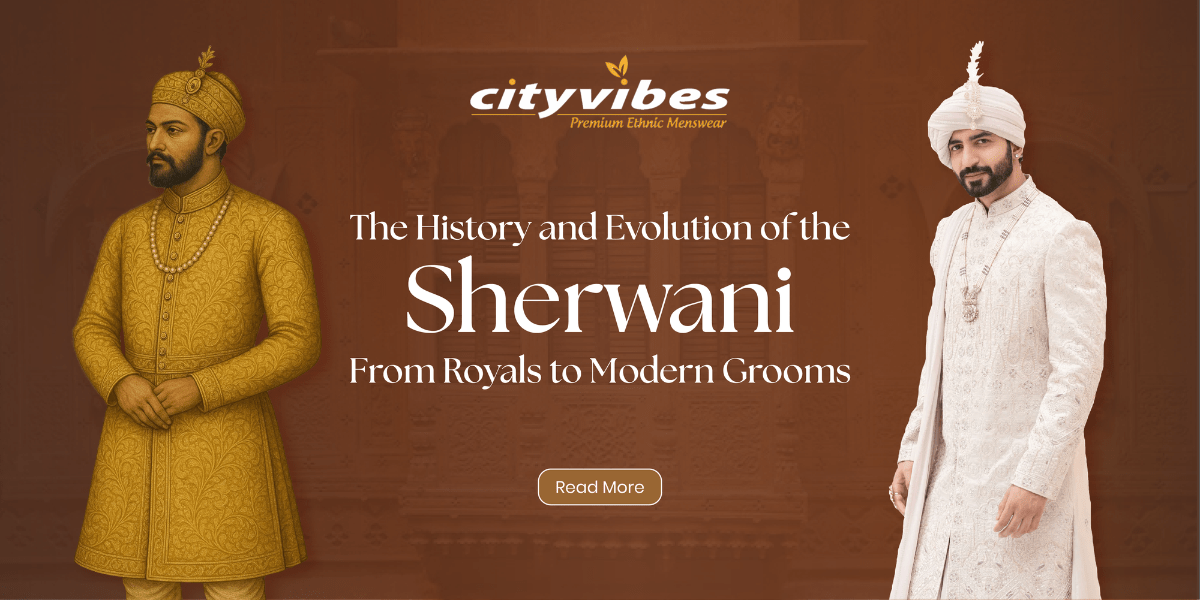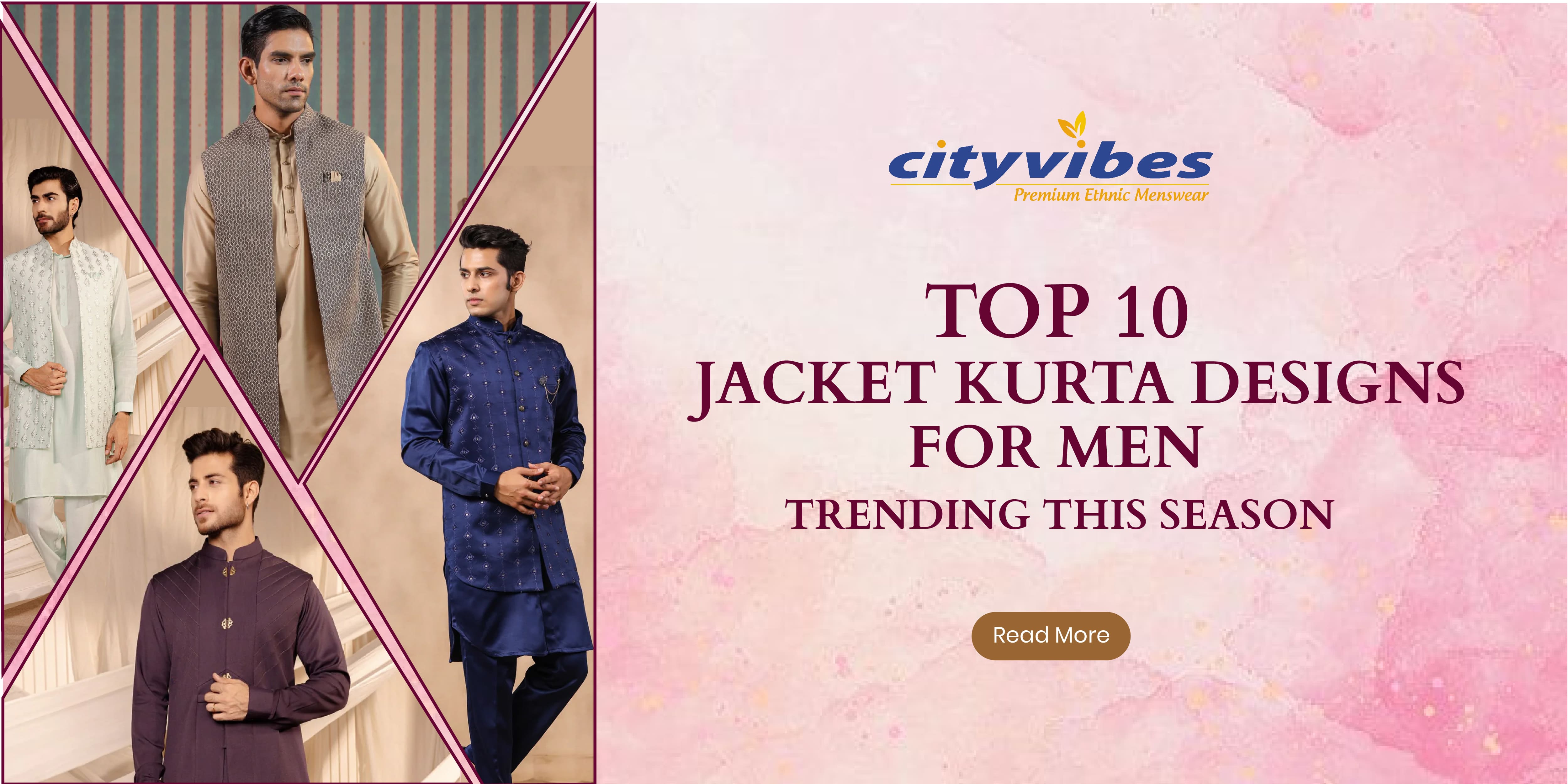
The History and Evolution of the Sherwani: From Royals to Modern Grooms
Let's discuss the sherwani—a piece that has lasted for centuries and remains one of the most dapper, elegant, and majestic pieces in men's attire. Once a piece worn exclusively by royal families centuries ago, today's sherwani has evolved into a go-to wedding-day attire for grooms everywhere. But how did this piece of garment transition from an exclusive attire for royalty into a wedding-day staple we're familiar with today? Well, take a sip from your cup of tea, and join me as I take you through an interesting history and evolution of the sherwani.
The Early Days: Royalty and Mughal Impact

The sherwani has its roots in the Mughal era in India. Imagine this: we are in the 16th century, and the Mughal emperors, who were known for their love for grandeur and luxury, have just landed on Indian soil. They did not just bring along their warfare prowess but also their own peculiar ways, including their style of dressing. The sherwani was one among those outfits which became iconic during that time.
Persian Roots in India
The sherwani has Persian roots, derived from the Persian term "shirwan" meaning coat or jacket. The style was picked up and developed further by the Mughals. The royal courts were filled with men dressed in long coat-like garments made from expensive fabrics such as silk, brocade, and velvet. The sherwanis were heavily embroidered in gold thread, and not merely for luxury, but for intricate detail as well. To Mughals, sherwani was not just an article of clothing—it was an emblem representing their imperial position, authority, and luxury.

Fundamentally, sherwani was a representation of Mughal life: lavish, elaborate, and closely intertwined with power. The sherwani was worn by the upper classes and was usually complemented by expensive accessories, which made sherwani the epitome of status and riches.
The Colonial Style: Evolving Fashions
With the arrival of the British in India, Western attire affected Indian attire as well. Although jackets and suits became prevalent, sherwani was not forgotten. Rather, sherwani developed and modified itself, just like the rest of Indian society did, in accordance with changing times.
The Nehru Jacket Emerges
The sherwani did not disappear into annals of history—instead, it evolved, particularly as India headed toward freedom from Britain. Among the ways that the sherwani evolved under British colonial rule was through the invention of the Nehru jacket. This was a shorter, more fitted adaptation of the sherwani itself that would come to represent nationalism for India. Introduced through Jawaharlal Nehru, who popularized it, the jacket was modern, sleek, and unlike the long, flowing robes that were part of Mughal history. It retained some essence of the sherwani while projecting a slimmed-down, modernized silhouette.
Its adaptation cemented its role as a matter of pride since Nehru and other distinguished leaders adopted it as an emblem for being free from British domination. The Nehru jacket served to revive the sherwani's use, rendering it more versatile and fashionable while still being firmly rooted in its traditional past.
The 20th Century: Sherwani as an Icon for Weddings
By the 1900s, sherwani was no longer exclusively a piece for royalty alone; it was an icon for weddings now. With weddings themselves becoming more lavish and integral to India's social scene, sherwani became a go-to attire for weddings for grooms as well.
From Royalty to Grooms
The sherwani emerged at an increasing number of weddings, particularly those of the upper class. With families placing growing emphasis upon weddings, including their importance, the sherwani soon became a standard for grooms' attire. Grooms wished to be dignified and elegant on their wedding day, and surely, what could be a better choice for this than the same attire previously reserved for royalty?
During these years, sherwanis became even costlier and fancier. Fabrics bearing embroidery, bead work, and lavish material were common. The weddings themselves became an event where the bridegroom, as much as the bride, was attired in his best wear. The sherwani perfectly fit into this storyline, emerging as a representation of luxury and sophistication.
The Contemporary Sherwani: Fit for Today's Groom
The sherwani has seen dramatic transformations in recent times, shifting from being a solely royal wear to a wedding essential today. Sherwanis today are sleek, well-fitted, and often come with an innovative twist but still holding onto what originally makes them stand out.
Slim-Fit Silhouettes
Those long, baggy sherwanis are history. The modern sherwani has adopted a tailored look now. Slim fit sherwanis are now the first choice, which provide a neater and sleeker look. Grooms no longer go for loose-fitting silhouettes but for a fitted look that not just fits well into their physique but provides maximum comfort throughout the entire wedding.
The slim-fit style is ideal for the groom who seeks elegance while maintaining comfort. For a grand wedding or a small, intimate wedding, the modern sherwani exudes flexibility, representing an ideal marriage between heritage and style.
Modern Fabrics and Cuts
Modern-day sherwanis come in a wide range of fabrics tailored for various climatic conditions and personal tastes. Lighter ones such as linen, georgette, and cotton are gaining popularity, particularly for destination weddings or for weddings during summer when heavier fabrics may not be comfortable. However, for winter weddings, velvet and brocade fabrics are still preferred.
The designers are experimenting not just with fabrics and embroidery but also with cuts and finishings, infusing modern elements into traditional designs. Stand-up collars, embroidered jackets, and minimalist details are all incorporated into today's sherwani. The overall style today favors a cleaner, sleeker look without compromising the garment's heritage and sophistication.
The Impact of Bollywood
Bollywood has always played an influential role in dictating fashion trends, and this is no different for the sherwani. Shah Rukh Khan, Ranveer Singh, and Virat Kohli are among those who have given a boost to the sherwani's popularity. Either on screen in romance films or off screen at weddings and social functions, Bollywood's top men continue to sport and promote the sherwani, which has become a synonym for sophistication and current style.
The Present-Day Sherwani: A Groom's Statement Piece
Flash forward to now, and the sherwani is as timeless as ever. No longer exclusive to the wealthy and famous—today, it’s the attire for any groom looking to turn heads on his wedding day. Whether ivory or maroon, a modern sherwani can be tailored according to any groom’s style and wedding vision.

Today, grooms require wedding wear that speaks about them and their personalities, and the sherwani provides them just that. It comes with personalization options—be that through customized embroidery, offbeat color options, or sleek modern cuts. The sherwani keeps building bridges between tradition and style, and that way, it will never fall behind in terms of wedding wear popularity.
Conclusion: The Lasting Legacy of Sherwani
It has come a long way from its royal heritage during the Mughal era to its current position as a wedding icon today. Being a once-upon-a-time royal court attire, it has transcended itself into an essential wedding attire for grooms today, evolving with style while still maintaining its traditional importance.
The sherwani continues to be a representation of sophistication, culture, and refinement, and will surely remain a focal aspect for wedding attire for generations to come. Worn in its most conventional state or in a modernized shape, the sherwani is much more than an article of attire—it’s a celebration of heritage, identity, and style.
FAQs: The Sherwani - From Royals to Modern Grooms
-
What is the origin of the sherwani?
The sherwani originated in Persia and was brought to India by the Mughal emperors during the 16th century. It became a symbol of royalty and was worn by the elite, including the emperors, nobles, and courtiers. -
How has the sherwani evolved over time?
The sherwani has evolved from a long, royal garment worn by Mughal rulers to a modern wedding outfit for grooms. During the colonial era, it adapted to incorporate Western tailoring elements, leading to the creation of the Nehru jacket, a more fitted, contemporary version. Today, sherwanis come in slim-fit cuts, with modern fabrics and colors to cater to current fashion trends. -
Is the sherwani only for weddings?
While the sherwani is most commonly worn by grooms at weddings, it is also worn for other festive occasions such as religious ceremonies, cultural events, and celebrations. It has become a symbol of sophistication and style, making it a versatile choice for formal events. -
What fabrics are used for modern sherwanis?
Modern sherwanis are crafted from a variety of fabrics, including traditional velvet and brocade, as well as lighter fabrics like cotton, linen, and georgette. These materials offer versatility and comfort for different climates, especially for destination or summer weddings. -
Can a sherwani be customized?
Yes, many designers offer customization options for sherwanis, allowing grooms to choose fabrics, colors, and embroidery styles that best suit their personal preferences and wedding theme. Customization ensures the groom’s sherwani is unique to his style. -
What is the difference between a sherwani and a kurta?
The sherwani is a long, tailored coat-like garment, often worn with a kurta underneath, whereas the kurta is a loose, knee-length tunic. While the kurta is more casual, the sherwani is more formal and ceremonial, often worn for weddings and special occasions. -
What accessories should be paired with a sherwani?
The sherwani is often accessorized with a safa (turban), pocket square, mojaris (traditional footwear), and jewelry like brooches, cufflinks, or bracelets. These accessories help complete the regal look and add a personalized touch to the outfit. -
Is the sherwani suitable for all body types?
Yes, the sherwani can be adapted to suit all body types. Modern sherwanis are available in slim-fit styles as well as more relaxed, traditional cuts, allowing for a more tailored or comfortable fit depending on personal preference. Customization options further ensure the best fit for the wearer. -
How do I care for a sherwani?
Due to the delicate fabrics and embroidery, sherwanis often require professional cleaning, especially if it has heavy embellishments. For lighter maintenance, it’s important to store the sherwani in a garment bag to protect it from dust and damage. Always check the care instructions provided by the designer or tailor. -
Why should I choose a sherwani for my wedding?
A sherwani is a timeless, elegant choice for weddings. It combines tradition with modern style, making it perfect for grooms who want to honor their heritage while looking sophisticated and stylish. With its rich history and versatility, the sherwani offers both cultural significance and contemporary appeal, making it a perfect outfit for your big day.




Leave a comment
This site is protected by hCaptcha and the hCaptcha Privacy Policy and Terms of Service apply.